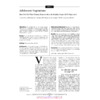 |
|
Lecture Notes | Approved: 7 years ago | 100.23 kB | Comments: 0
...AdolescentVegetariansHowWellDoTheirDietaryPatternsMeettheHealthyPeople2010Objectives?CherylL.Perry,PhD;MaureenT.McGuire,PhD;DianneNeumark-Sztainer,PhD,RD;MaryStory,PhD,RDToexaminewhetheradolescentvegetar-iansweremorelikelythannonvegetarianpeerstomeetthedietaryrecommendationsoftheHealthyPeople2010objectivesandtoexaminedifferencesinothernutrientsbetweenthese2groups.Atotalof4746adolescentsfrom31middleandhighschoolsintheTwinCitiesareaofMinnesota.Datawerecollectedviaself-reportsurveys,withastudentre-sponserateof81.5%.Urbansecondaryschools.Participantswereequallydividedbysex.Themeanagewas14.9years;34.3%wereinjuniorhighschooland65.7%inhighschool.Theracial/ethnicdis-tributionwas48.5%white,19.0%AfricanAmerican,19.2%AsianAmerican,5.8%Hispanic,3.5%AmericanIndian,and3.9%mixedorother.MainOutcomeMeasures:Questionsonvegetariansta-tusandwhetherparticularfoods(eggs,dairyfoods,chicken,fish)wereexcluded.DietaryintakewasassessedusingtheYouthandAdolescentFoodFrequencyQuestionnaire.VegetarianadolescentsweresignificantlymorelikelythannonvegetarianadolescentstomeettheHealthyPeople2010objectives.Thiswasparticularlynotewor-thyfortotalfat(70%vs48%),saturatedfat(65%vs39%),dailyservingsofvegetables(26%vs14%),and5ormoreservingsoffruitsandvegetables(39%vs28%).Vegetar-ianswerealsolesslikelytoeatfastfoodordrinkregularsodaandfruitdrinks.Vegetariansconsumedlessvita-minB,moredietsoda,morecaffeine,andmoreiron.Adolescentvegetarianshaveadietarypat-ternthatismorelikelythannonvegetarianstomeettheHealthyPeople2010objectives.ArchPediatrAdolescMed.2002;156:431-437 foravarietyofreasons,choosetolimittheirintakeofmeatandotheranimalproducts.Somevegetarianseatnoanimalproducts(vegans),whereasothersincludemilkproducts(lactovegetarians)oreggs(ovovegetarians).Manyself-iden-tifiedvegetariansalsoeatsomemeat,par-ticularlyfishandchicken(semivegetarians).Adultvegetarianismhasbeenstudiedfortherelationshipsamongaplant-baseddiet,chronicdiseases,andlengthoflife.all,adultvegetarianstendtolivesignifi-cantlylongerlivesthannonvegetarians,withsubstantiallylowerratesofcardiovasculardiseases,hypertension,type2diabetesmelli-tus,obesity,andsometypesofcancer.Vegetariandiets,likealldiets,needtobeplannedappropriatelytobenutrition-allyadequate.Ofconcernwithadultveg-etariansissufficientconsumptionofnutri-entsoftenfoundinanimalproducts.Nutrientsofmostconcernincludeiron,calcium,zinc,andvitaminBWhiteandpointoutthatclinicalnutritiondeficienciesareuncommonevenamongvegans,althoughtheysuggestthatcare-fulplanningand,insomecases,vitaminsupplementationmaybewarranted.Theintakeofthesenutrientshasnotbeenex-aminedinalargeadolescentvegetarianGiventhatdietarypatternsareadoptedandappeartobemaintainedduringado-lescenceandyoungadulthood,anin-terestingquestioniswhetheryoungerveg-etariansreporthealthierdietarypatternsthannonvegetariancounterparts.Specifi-cally,whatpercentageofadolescentveg-etarians(vsnonvegetarians)complywiththedietaryrecommendationsoutlinedintheHealthyPeople2010objectives?Doadolescentvegetariansconsumelessfatandsaturatedfat,consumemorefruitsandvegetablesandfiber,andmaintainhealthierForeditorialcommentseepage426 FromtheDivisionofEpidemiology,SchoolofPublicHealth,UniversityofMinnesota,Minneapolis. (REPRINTED)ARCHPEDIATRADOLESCMED/VOL156,MAY2002WWW.ARCHPEDIATRICS.COM ©2002AmericanMedicalAssociation.Allrightsreserved. on March...
...March 17, 2009 www.archpediatrics.com Downloaded from intakelevelsofothernutrients,suchascalcium,thandoadolescentnonvegetarians?Or,alternatively,areadoles-centvegetariansatincreasedriskforinadequateintakeofanyofthesefoodsornutrients?Thesequestionsareim-portantsincedietarybehaviorshaveimplicationsforado-lescents’currentandfuturehealth.Inapriorstudy,Neumark-Sztaineretalfoundthatadolescentvegetar-iansweretwiceaslikelytoconsumefruitsandvegetables,onethirdaslikelytoconsumesweets,lesslikelytocon-sumedairyproducts,andonefourthaslikelytoconsumesaltysnackfoodscomparedwithnonvegetarians.Dono-vanandGibsonfoundthatmeandailyintakesofenergyandmostnutrientswerecomparableforvegetariansandnonvegetarianadolescents.Adolescentvegetariansintheirstudy,however,consumedfewerdairyproducts,meat,andsweetsandmorelegumes,nuts,andvegetablesthandidThestudieswithadolescentvegetar-ians,however,havebeenlimitedintheirassessmentofdiet,hadsmallsamplesofvegetarians,andhavenotincludedamultiracial,multiethnicgroupofsubjects.DataforthecurrentstudyweredrawnfromProjectEAT(EatingAmongTeens),acomprehensivestudyofado-lescenteatingpatternsandweightconcerns.Alargegroupofurbanadolescentsfrommultipleethnicgroupsinthisstudyprovidedtheopportunitytoexaminetheeatingpat-ternsandnutrientintakeofadiversepopulationofadoles-cents.Wehypothesizedthatadolescentswhoreportedtobevegetarians,comparedwithnonvegetarianpeers,wouldbemorelikelytomeetthedietaryrecommendationsoftheHealthyPeople2010objectivesbutmighteatlessofsomenutrients,particularlycalcium,iron,vitaminB,andpos-siblyvitaminB.Finally,wehypothesizedthatmorestrin-gentvegetarians,thosewhodidnoteatfishandchicken,wouldbemorelikelytomeetthedietaryrecommendationsofHealthyPeople2010relatedtofat,fruits,andvegetables....
...from intakelevelsofothernutrients,suchascalcium,thandoadolescentnonvegetarians?Or,alternatively,areadoles-centvegetariansatincreasedriskforinadequateintakeofanyofthesefoodsornutrients?Thesequestionsareim-portantsincedietarybehaviorshaveimplicationsforado-lescents’currentandfuturehealth.Inapriorstudy,Neumark-Sztaineretalfoundthatadolescentvegetar-iansweretwiceaslikelytoconsumefruitsandvegetables,onethirdaslikelytoconsumesweets,lesslikelytocon-sumedairyproducts,andonefourthaslikelytoconsumesaltysnackfoodscomparedwithnonvegetarians.Dono-vanandGibsonfoundthatmeandailyintakesofenergyandmostnutrientswerecomparableforvegetariansandnonvegetarianadolescents.Adolescentvegetariansintheirstudy,however,consumedfewerdairyproducts,meat,andsweetsandmorelegumes,nuts,andvegetablesthandidThestudieswithadolescentvegetar-ians,however,havebeenlimitedintheirassessmentofdiet,hadsmallsamplesofvegetarians,andhavenotincludedamultiracial,multiethnicgroupofsubjects.DataforthecurrentstudyweredrawnfromProjectEAT(EatingAmongTeens),acomprehensivestudyofado-lescenteatingpatternsandweightconcerns.Alargegroupofurbanadolescentsfrommultipleethnicgroupsinthisstudyprovidedtheopportunitytoexaminetheeatingpat-ternsandnutrientintakeofadiversepopulationofadoles-cents.Wehypothesizedthatadolescentswhoreportedtobevegetarians,comparedwithnonvegetarianpeers,wouldbemorelikelytomeetthedietaryrecommendationsoftheHealthyPeople2010objectivesbutmighteatlessofsomenutrients,particularlycalcium,iron,vitaminB,andpos-siblyvitaminB.Finally,wehypothesizedthatmorestrin-gentvegetarians,thosewhodidnoteatfishandchicken,wouldbemorelikelytomeetthedietaryrecommendationsofHealthyPeople2010relatedtofat,fruits,andvegetables. Fromthetotalsampleofstudents,4521adolescentshadcompletedtheYAQandhadusabledata,and262(5.8%)POPULATIONANDMETHODSSAMPLEANDSTUDYDESIGNThestudypopulationincluded4746adolescentsfrom31publicmiddleschoolsandhighschoolsintheTwinCitiesareaofMinnesota.Participantswereequallydividedbysex(50.2%male,49.8%female).Themeanageofthestudypopulationwas14.9years(range,11-18years);34.3%wereinjuniorhighschooland65.7%inhighschool.Theracial/ethnicbackgroundsoftheparticipantswereasfollows:48.5%white,19.0%AfricanAmerican,19.2%AsianAmeri-can,5.8%Hispanic,3.5%AmericanIndian,and3.9%mixedorother.MostoftheAsianAmericanpopulationwasfromSoutheastAsia.Dataforthisstudywerecollectedviaself-reportsur-veysandanthropometricassessmentsinthe1998-1999schoolyear.Thedatawerecollectedinschoolswithinhealth,physi-caleducation,andscienceclassroomsinone90-minutepe-riodortwo50-minuteperiods.Trainedresearchstaffad-ministeredthesurveysintheclassroomsandmeasuredheightandweightinaprivatearea.Studyprocedureswereap-provedbytheUniversityofMinnesotaHumanSubjects’Committeeandbyresearchboardsoftheparticipatingschooldistricts.Consentproceduresalsofollowedtherequire-mentsoftheparticipatingschooldistricts.Insomeschools,passiveconsentprocedureswereused,whereasinothersactiveconsentprocedureswererequired.Theresponserateforstudentparticipationwas81.5%.Themainreasonsforlackofparticipationwereabsenteeismandfailuretoreturnconsentformswithinschoolsrequiringactiveconsent.VegetarianItemsToidentifyvegetarians,allstudentswereaskedonthesur-veytorespondyesornotothequestion,“Areyouaveg-etarian?”Thosewhoansweredyeswereaskedtorespondtoadditionalquestions.Thefirstwas“Asavegetarian,doyoueatanyofthefollowing?(1)Eggs;(2)Dairyfood(suchasmilk,cheese);(3)Chicken;(4)Fish.”Studentswhocheckednotochickenandfishwerelabeledlacto-ovo-vegans.Studentswhocheckedyestoeitherchickenorfishwerelabeledsemivegetarians.SociodemographicItemsDemographicfactors,includingsex,ethnicity/race,schoollevel,andsocioeconomicstatus(SES),werebasedonself-report.Ethnicity/racewasassessedwiththequestion,“Doyouthinkofyourselfas...(1)White;(2)BlackorAfricanAmerican;(3)HispanicorLatino;(4)AsianAmerican;(5)HawaiianorPacificIslander;or(6)AmericanIndianorNa-tiveAmerican?”Youthweregiventheoptionofchoosingmultipleresponses,andthosereportingmorethanonere-sponse(otherthanwhite)werecodedasmixedorother.Schoollevelwasdividedintomiddleschool(7ththrough8thgrades)andhighschool(9ththrough12thgrades).TheprimedeterminantofSESwasparentaleducationallevel,definedbythehigherlevelofeitherparent.Responsecat-egoriesforquestionsonparentaleducationallevelwereasfollows:(1)didnotfinishhighschool;(2)finishedhighschoolorreceivedgeneralequivalencydiploma;(3)somecollege;(4)finishedcollege;(5)master’sorPhDdegree;and(6)don’tknow.OthervariablesusedtoassessSESincludedthefollowing:familyeligibilityforpublicassistance(yes,no,ordon’tknow),eligibilityforfreeorreduced-costschoolmeals(yes,no,ordon’tknow),andemploymentstatusofmotherandfather(full-time,part-time,networking,ordon’tknow).Analgorithmwasdevelopedtoavoidclassifyingado-lescentsashavinghighSES,basedonparentaleducationlev-els,iftheywerereceivingpublicassistance,eligibleforfreeorreduced-costschoolmeals,orhad2unemployedpar-ents(or1unemployedparentiffromasingle-parenthousehold).StudentswereclassifiedashavinglowSES,middleSES,orhighSES.DietaryIntakeAssessmentofdietaryintakewasperformedwiththe149-itemYouthandAdolescentFoodFrequencyQuestionnaire (REPRINTED)ARCHPEDIATRADOLESCMED/VOL156,MAY2002WWW.ARCHPEDIATRICS.COM ©2002AmericanMedicalAssociation.Allrightsreserved. on March...
...March 17, 2009 www.archpediatrics.com Downloaded from reportedbeingvegetarian.Amongthevegetarians,nearlythreefourths(73.7%)werefemale.Nearlyhalf(47.5%)ofthevegetarianswerewhite,26.8%wereAsian,11.1%wereAfricanAmerican,5.8%wereHispanic,5.0%wereAmericanIndian,andtheremaining4%wereHawaiianorPacificIslanderorother.BecausethereweresofewHis-panic,AmericanIndian,andmixedorothervegetarians(be-causeofthesamplesizesofthoserace/ethnicitiesintheen-tiresample),thesegroupswerecombinedandreferredtoasotherintherace/ethnicityanalyses.Amongthevegetar-ians,38.6%wereinhighschool(vsmiddleorjuniorhighschool).Morethanhalfofthevegetarians(62%)reportedeatingchickenand/orfishandweresemivegetarians;32%ateeggsand/ordairyproducts(butnotchickenorfish),and6%werevegans,sothat38%wereclassifiedaslacto-ovo-vegansfortheseanalyses.AsgiveninTable1,thereweresignificantdifferencesbetweenvegetariansandnon-vegetariansinthesexandracialmakeupofthesamples.Overall,adolescentvegetariansweresignificantlymorelikelytomeetthedietaryrecommendationsofHealthyPeople2010asgiveninTable2.Vegetarianado-lescentsweremorethantwiceaslikelytoeatlessthan30%oftheircaloriesfromfatandnearly3timesmorelikelytoeatlessthan10%oftheircaloriesfromsatu-ratedfat.Theywerealso1.4to2timesmorelikelytoeat2ormoreservingsoffruit,3ormoreservingsofveg-etables,3ormoreservingsofvegetablesincluding1thatisdarkyelloworgreen,and5ormoreservingsoffruitsandvegetablesdaily.Therewerenosignificantdiffer-encesindailycalciumintakeorservingsofgrains.Therewerealsonosignificantsexvegetarianstatusorracevegetarianstatusinteractions.Differencesbetweenvegetariansandnonvegetar-iansforavarietyofotherfoodintakevariablesaregivenTable3.Vegetarianadolescents,comparedwithnonvegetarianadolescents,consumedsignificantlylessvitaminB,cholesterol,regularsoda,fruitdrink,andfastfood,aswellasthepercentageofcaloriesfrompro-teinandalltypesoffat.Vegetariansweresignificantlymorelikelythannonvegetarianstoconsumemoreiron,(YAQ).TheYAQasksaboutspecificfooditems,identifiesamountsofeachfood,andasksforfrequencyofconsump-tion.Forexample,onequestionasksabouthowfre-quently2piecesofpizzaareconsumed(never,1-3timespermonth,onceaweek,2-4timesperweek,5timesperweek).ValidityandreliabilityoftheYAQhavebeentestedamongarandomsampleofchildren(aged9-18years)ofparticipantsintheNursesHealthStudyandfoundtobewithinacceptablerangesfordietaryassessmenttools.Meancorrelationforenergy-adjustednutrientsbetweentwoYAQsandthree24-hourrecalls(implementedin3sea-sons)was0.45.Themeanenergyintake(incalories)fortheYAQwashigherthanfortherecallsbutwithin1%ofthem.Test-retestcorrelationsbetween2YAQsduringa1-yearperiodwere0.49forfruitand0.48forvegetables.Responsestoquestionsonthefrequencyofintakeofthefollowingfruitsandvegetablesweresummedtoassessaveragetotaldailyintakeoffruitsandvegetables:apples,applejuice,bananas,beets,broccoli,carrots,celery,cole-slaw,corn,grapes,greensorkale,lettuce,melon,mixedvegetables,oranges,orangejuice,peachesorplums,pears,peas,peppers,potatoes(notincludingFrenchfries),rai-sins,spinach,strawberries,stringbeans,tomatoes,to-matoorspaghettisauce,yams,andzucchiniorsquash.Con-sumptionoffruitsandvegetableswasgenerallyreportedusing5-pointscales(eg,neverorlessthanonceamonth,1-3timespermonth,onceaweek,2-4timesperweek,timesperweek).Dietaryintakeinthepresentstudywasevaluatedin2ways:relativetotheHealthyPeople2010objectives(forrelevantnutrientsandfoods)andasmeandailyintake.Inthecurrentstudy,nutrientandfoodbehaviorsexaminedrelativetotheHealthyPeople2010objectivesincludedthefollowing:totalfat(percentageoftotalenergy),saturatedfat(percentageoftotalenergy),calcium(milligrams),fruits(servings),vegetables(servings),andgrains(servings).ThesewereconvertedtothepercentageofstudentswhocompliedwiththeHealthyPeople2010objectives.Otherdailynutrientintakesincludedthefollowing:calories(ki-localories),protein(grams),calcium(milligrams),zinc(mil-ligrams),iron(milligrams),vitaminA(units),vitaminB(milligrams),vitaminB(micrograms),vitaminC(milli-grams),folate(micrograms),linoleicacid(grams),cho-lesterol(milligrams),caffeine(milligrams),andfiber(grams).Otherdailyfoodintakesincludedsoda(dailyserv-ings),dietsoda(dailyservings),fruitdrink(noncarbon-ated,dailyservings),andfastfood(frequencyinthepastweek).Wealsoexaminedthepercentageofcaloriesfromprotein,carbohydrates,totalfat,saturatedfat,polyunsatu-ratedfat,andmonounsaturatedfat,aswellastheaveragedailyservingsoffruitandvegetables.Thesewereselectedtoassesswhethervegetarianswereatgreaterorlesserriskthannonvegetariansfornutrientinadequaciesofparticu-larconcernduringadolescence.DATAANALYSESThepresentstudyassesseddietaryintakeassociatedwithadolescentvegetarians.Inthefirstsetofanalyses,theper-centagesofadolescentswhomettheHealthyPeople2010dietaryobjectiveswerecomparedbetweenvegetariansandnonvegetarians.Theseanalysesalsoassessedwhetherdi-etaryintakewasmoderatedbysex(ie,sex-by-vegetarianinteractions)orrace/ethnicity(ie,race/ethnicityvegetarianinteractions).Dailyintakeofspecificnutrientsandfoodswasalsocomparedbetweenvegetariansandnonveg-etarians.Inthesecondsetofanalyses,thepercentagesofado-lescentswhometHealthyPeople2010objectiveswerecom-paredbetweenspecificvegetariangroups.Fortheseanalyses,vegetarianswhowerelacto-ovo-veganswerecomparedwithsemivegetarians.Logisticandlinearregressionanalyseswereconductedtotestforstatisticaldifferencesbetweenthecom-parisongroupswhenthedependentvariableswereeitherdi-chotomousorlinear,respectively.Allanalysescontrolledforsexandracesincethereweredifferencesbetweengroupsinsexandracialmake-up.Theinteractionanalysesbysexandracewerecontrolledforraceorsex,respectively..05wasconsideredsignificant.valueswerenotadjustedformul-tipletestingbecausefalse-positivedifferenceswereun-likelywhenthevaluesaresmall(.01),whichwasthecaseformostofthecomparisons.Allanalyseswerecon-ductedusingtheStatisticalAnalysisSystem....
...Downloaded from reportedbeingvegetarian.Amongthevegetarians,nearlythreefourths(73.7%)werefemale.Nearlyhalf(47.5%)ofthevegetarianswerewhite,26.8%wereAsian,11.1%wereAfricanAmerican,5.8%wereHispanic,5.0%wereAmericanIndian,andtheremaining4%wereHawaiianorPacificIslanderorother.BecausethereweresofewHis-panic,AmericanIndian,andmixedorothervegetarians(be-causeofthesamplesizesofthoserace/ethnicitiesintheen-tiresample),thesegroupswerecombinedandreferredtoasotherintherace/ethnicityanalyses.Amongthevegetar-ians,38.6%wereinhighschool(vsmiddleorjuniorhighschool).Morethanhalfofthevegetarians(62%)reportedeatingchickenand/orfishandweresemivegetarians;32%ateeggsand/ordairyproducts(butnotchickenorfish),and6%werevegans,sothat38%wereclassifiedaslacto-ovo-vegansfortheseanalyses.AsgiveninTable1,thereweresignificantdifferencesbetweenvegetariansandnon-vegetariansinthesexandracialmakeupofthesamples.Overall,adolescentvegetariansweresignificantlymorelikelytomeetthedietaryrecommendationsofHealthyPeople2010asgiveninTable2.Vegetarianado-lescentsweremorethantwiceaslikelytoeatlessthan30%oftheircaloriesfromfatandnearly3timesmorelikelytoeatlessthan10%oftheircaloriesfromsatu-ratedfat.Theywerealso1.4to2timesmorelikelytoeat2ormoreservingsoffruit,3ormoreservingsofveg-etables,3ormoreservingsofvegetablesincluding1thatisdarkyelloworgreen,and5ormoreservingsoffruitsandvegetablesdaily.Therewerenosignificantdiffer-encesindailycalciumintakeorservingsofgrains.Therewerealsonosignificantsexvegetarianstatusorracevegetarianstatusinteractions.Differencesbetweenvegetariansandnonvegetar-iansforavarietyofotherfoodintakevariablesaregivenTable3.Vegetarianadolescents,comparedwithnonvegetarianadolescents,consumedsignificantlylessvitaminB,cholesterol,regularsoda,fruitdrink,andfastfood,aswellasthepercentageofcaloriesfrompro-teinandalltypesoffat.Vegetariansweresignificantlymorelikelythannonvegetarianstoconsumemoreiron,(YAQ).TheYAQasksaboutspecificfooditems,identifiesamountsofeachfood,andasksforfrequencyofconsump-tion.Forexample,onequestionasksabouthowfre-quently2piecesofpizzaareconsumed(never,1-3timespermonth,onceaweek,2-4timesperweek,5timesperweek).ValidityandreliabilityoftheYAQhavebeentestedamongarandomsampleofchildren(aged9-18years)ofparticipantsintheNursesHealthStudyandfoundtobewithinacceptablerangesfordietaryassessmenttools.Meancorrelationforenergy-adjustednutrientsbetweentwoYAQsandthree24-hourrecalls(implementedin3sea-sons)was0.45.Themeanenergyintake(incalories)fortheYAQwashigherthanfortherecallsbutwithin1%ofthem.Test-retestcorrelationsbetween2YAQsduringa1-yearperiodwere0.49forfruitand0.48forvegetables.Responsestoquestionsonthefrequencyofintakeofthefollowingfruitsandvegetablesweresummedtoassessaveragetotaldailyintakeoffruitsandvegetables:apples,applejuice,bananas,beets,broccoli,carrots,celery,cole-slaw,corn,grapes,greensorkale,lettuce,melon,mixedvegetables,oranges,orangejuice,peachesorplums,pears,peas,peppers,potatoes(notincludingFrenchfries),rai-sins,spinach,strawberries,stringbeans,tomatoes,to-matoorspaghettisauce,yams,andzucchiniorsquash.Con-sumptionoffruitsandvegetableswasgenerallyreportedusing5-pointscales(eg,neverorlessthanonceamonth,1-3timespermonth,onceaweek,2-4timesperweek,timesperweek).Dietaryintakeinthepresentstudywasevaluatedin2ways:relativetotheHealthyPeople2010objectives(forrelevantnutrientsandfoods)andasmeandailyintake.Inthecurrentstudy,nutrientandfoodbehaviorsexaminedrelativetotheHealthyPeople2010objectivesincludedthefollowing:totalfat(percentageoftotalenergy),saturatedfat(percentageoftotalenergy),calcium(milligrams),fruits(servings),vegetables(servings),andgrains(servings).ThesewereconvertedtothepercentageofstudentswhocompliedwiththeHealthyPeople2010objectives.Otherdailynutrientintakesincludedthefollowing:calories(ki-localories),protein(grams),calcium(milligrams),zinc(mil-ligrams),iron(milligrams),vitaminA(units),vitaminB(milligrams),vitaminB(micrograms),vitaminC(milli-grams),folate(micrograms),linoleicacid(grams),cho-lesterol(milligrams),caffeine(milligrams),andfiber(grams).Otherdailyfoodintakesincludedsoda(dailyserv-ings),dietsoda(dailyservings),fruitdrink(noncarbon-ated,dailyservings),andfastfood(frequencyinthepastweek).Wealsoexaminedthepercentageofcaloriesfromprotein,carbohydrates,totalfat,saturatedfat,polyunsatu-ratedfat,andmonounsaturatedfat,aswellastheaveragedailyservingsoffruitandvegetables.Thesewereselectedtoassesswhethervegetarianswereatgreaterorlesserriskthannonvegetariansfornutrientinadequaciesofparticu-larconcernduringadolescence.DATAANALYSESThepresentstudyassesseddietaryintakeassociatedwithadolescentvegetarians.Inthefirstsetofanalyses,theper-centagesofadolescentswhomettheHealthyPeople2010dietaryobjectiveswerecomparedbetweenvegetariansandnonvegetarians.Theseanalysesalsoassessedwhetherdi-etaryintakewasmoderatedbysex(ie,sex-by-vegetarianinteractions)orrace/ethnicity(ie,race/ethnicityvegetarianinteractions).Dailyintakeofspecificnutrientsandfoodswasalsocomparedbetweenvegetariansandnonveg-etarians.Inthesecondsetofanalyses,thepercentagesofado-lescentswhometHealthyPeople2010objectiveswerecom-paredbetweenspecificvegetariangroups.Fortheseanalyses,vegetarianswhowerelacto-ovo-veganswerecomparedwithsemivegetarians.Logisticandlinearregressionanalyseswereconductedtotestforstatisticaldifferencesbetweenthecom-parisongroupswhenthedependentvariableswereeitherdi-chotomousorlinear,respectively.Allanalysescontrolledforsexandracesincethereweredifferencesbetweengroupsinsexandracialmake-up.Theinteractionanalysesbysexandracewerecontrolledforraceorsex,respectively..05wasconsideredsignificant.valueswerenotadjustedformul-tipletestingbecausefalse-positivedifferenceswereun-likelywhenthevaluesaresmall(.01),whichwasthecaseformostofthecomparisons.Allanalyseswerecon-ductedusingtheStatisticalAnalysisSystem. (REPRINTED)ARCHPEDIATRADOLESCMED/VOL156,MAY2002WWW.ARCHPEDIATRICS.COM ©2002AmericanMedicalAssociation.Allrightsreserved. on March...
...March 17, 2009 www.archpediatrics.com Downloaded from vitaminA,folate,caffeine,fiber,anddietsoda,aswellasagreaterpercentageofcaloriesfromcarbohydratesandmoreservingsoffruitandvegetables.Therewerenon-significantdifferencesbetweenthe2groupsforcalo-ries,protein,calcium,zinc,vitaminB,vitaminC,andlinoleicacid.Amongthevegetarians,differencesbetweenthelacto-ovo-vegansandsemivegetarians(whoatechickenand/orfish)wereexamined.TheresultsforthepercentageofeachgroupwhometthedietaryguidelinesoftheHealthyPeople2010objectivesaregiveninTable4.Lacto-ovo-vegansweremorethantwiceaslikelyassemivegetar-ianstoeatlessthan30%ofthecaloriesintheirdietfromfat,morethan2servingsoffruitperday,and5ormoreservingsoffruitsandvegetablesperday.Comparinglacto-ovo-veganswithsemivegetar-ians,therewerenointeractionsbetweenadherencetotheHealthyPeople2010objectivesbysex,buttherewere5significantinteractionsbyrace.Whitesemivegetariansweresignificantlylesslikelythanwhitelacto-ovo-veganstomeetthedailyrequirementforcalcium(22.6%vs43.9%;oddsratio,0.37;95%confidenceinter-val,0.16-0.82),toeatmorethan2servingsoffruiteachday(34.5%vs68.6%;OR,0.24;95%CI,0.11-0.54),toeatmorethan3servingsofvegetableseachday(8.6%vs35.3%;OR,0.17;95%CI,0.06-0.49),toeatmorethan3vegetableseachday,including1deepyelloworgreenvegetable(6.2%vs22.8%;OR,0.22;95%CI,0.07-0.74),andtoeat6ormoreservingsofgrainseachday(30.0%vs53.7%;OR,0.36;95%CI,0.17-0.79).Therewerenosignificantdifferencesbetweenlacto-ovo-vegansandsemivegetariansontheseitemsamongAfri-canAmericans,Asians,orothers....
...Table2.PercentagesofAdolescentsWhoMetHealthyPeople2010ObjectivesbyVegetarianStatus HealthyPeople2010ObjectivesVegetarian,%(n=262)Nonvegetarian,%(n=4259)OR(95%CI)Fatintake30%ofcaloriesfromfat69.547.52.34(1.74-3.14)10%ofcaloriesfromsaturatedfat65.039.02.62(1.97-3.48)Calciumintake,mg130029.735.00.93(0.69-1.25)Fruitandvegetableintake2Servingsoffruit54.245.31.42(1.07-1.88)3Servingsofvegetables26.413.92.16(1.56-2.98)3Servingsofvegetablesofwhichatleast1isdeepyelloworgreen19.19.62.12(1.53-2.95)5Servingsoffruitsorvegetables38.928.11.56(1.17-2.09)Grainintake6Servingsofgrains42.240.31.19(0.91-1.57) Nonvegetarianisthereferencegroup.Allanalyseswerecontrolledforsexandrace.ORindicatesoddsratio;CI,confidenceinterval. (REPRINTED)ARCHPEDIATRADOLESCMED/VOL156,MAY2002WWW.ARCHPEDIATRICS.COM ©2002AmericanMedicalAssociation.Allrightsreserved. on March...
...March 17, 2009 www.archpediatrics.com Downloaded from differencesbetweenvegetariansandnonvegetariansweregreaterforfatconsumptionandvegetableintakethandif-ferencesbetweenmaleandfemaleadolescents,thosewithlowSESandhighSES,andwhiteandblackpopula-tions,asreportedinapriorstudywiththissamepopu-lation.Althoughthesearenotidealcomparisons,theydoprovidepopulationgroupsthatsuggesthowsizablethedifferenceswerebetweenvegetarianandnonvegetar-iandietarypatterns.Therewerepositiveandnegativeaspectsoftheado-lescentvegetariandietarypatternswhenexaminingotheraspectsoftheirdiet.Forexample,adolescentvegetarianswerelesslikelythannonvegetarianpeerstoeatfastfoodordrinksodaandfruitdrinksandmorelikelytoconsumemorecarbohydrates,iron,fiber,andvitaminA.Thesedi-etaryfactorsaddtothepictureofahealthieroveralldi-etarypatternforthevegetariansandareconsistentwiththedataonfat,fruits,andvegetables.Itisparticularlyimpor-tantthatironintakewashigheramongvegetarianssincetheabsorptionofironfromvegetablesourcesisgenerallylowerthanfrommeatsources.However,vegetarianado-lescents,comparedwithnonvegetarians,consumedlessvi-taminB,whichmaybeimportantforfuturehealth.Veg-etariansalsoconsumedmarginallylessprotein.Theyconsumed,onaverage,70gofprotein(62gforthelacto-ovo-vegans),whichissufficientforgrowthanddevelop-Therecommendeddailyallowanceforproteinfor15-to18-year-oldsis44g/dforgirlsand59g/dforboys.Althoughadequateproteinisessentialforgrowth,plantsourcesofproteinalonecanprovideadequateamountsofessentialaminoacidsifavarietyofplantfoodsarecon-sumedandenergyneedsaremet.Mostvegetarian(70%)andnonvegetarian(65%)ado-lescentsdidnotmeettherecommendedintake(1300mg/d)forcalcium.Therewerenosignificantdiffer-encesbetweenvegetarianandnonvegetariancalciumintakesorbetweenlacto-ovo-vegansandsemivegetar-calciumintakes.Otherstudieshavefoundthatlacto-ovo-vegetarianshavecalciumintakesthatarecompa-rabletoorhigherthanthoseofnonvegetarians.meetcalciumrequirements,adolescentvegetariansandnonvegetariansshouldconsumecalcium-richorcalcium-fortifiedfoods,oriftheyareunwillingorunabletodothis,theyshouldtakesupplementalcalcium.Therewerefewdifferencesbetweenlacto-ovo-vegansandsemivegetarians.Ashypothesized,thelacto-ovo-vegansweremorelikelytomeettheHealthyPeople2010objectivesfortotalfat,fruit,and5ormoredailyservingsoffruitsandvegetablescomparedwithsemi-Table3.DifferencesinSelectedDietaryFactorsBetweenVegetariansandNonvegetarians...
...DataarepresentedasadjustedmeansandSEs;allanalyseswerecontrolledforsexandrace.Table4.PercentagesofSpecificTypesofAdolescentVegetariansWhoMetHealthyPeople2010Objectives HealthyPeople2010ObjectivesLacto-Ovo-Vegan,%(n=94)Semivegetarian,%(n=158)OR(95%CI)Fatintake30%ofcaloriesfromfat79.564.12.02(1.06-3.87)10%ofcaloriesfromsaturatedfat71.162.61.38(0.76-2.52)Calciumintake,mg130034.826.41.49(0.83-2.65)Fruitorvegetableintake2Servingsoffruit64.646.82.17(1.21-3.87)3Servingsofvegetables31.722.61.65(0.87-3.12)3Servingsofvegetablesofwhichatleast1isdeepyelloworgreen21.317.11.29(0.67-2.50)5Servingsoffruitsorvegetables50.030.62.36(1.31-4.24)Grainintake6Servingsofgrains44.740.01.26(0.72-2.22) Semivegetarianisthereferencegroup.Allanalyseswerecontrolledforsexandrace.ORindicatesoddsratio;CI,confidenceinterval. (REPRINTED)ARCHPEDIATRADOLESCMED/VOL156,MAY2002WWW.ARCHPEDIATRICS.COM ©2002AmericanMedicalAssociation.Allrightsreserved. on March...
...March 17, 2009 www.archpediatrics.com Downloaded from Itisimportanttoaddresssubstantivedifferencesbe-tweenvegetariansandnonvegetariansthatmightac-countforthedietarydifferencesobservedinthisstudy.Thesedemographicandpsychosocialdifferenceswerethefocusofapriorpublicationwiththissamepopulationofstudents.Theadolescentvegetariansweremorelikelythannonvegetarianstobefemale,notAfricanAmeri-can,inmiddleschool(ratherthanhighschool),weightandbodyconscious,dissatisfiedwiththeirbodies,andinvolvedinavarietyofhealthyandunhealthyweightcon-trolbehaviors.Inaddition,vegetariansmoreoftenre-portedhavingbeentoldbyaphysicianthattheyhadaneatingdisorderandweremorelikelytohavecontem-platedandattemptedsuicide.Otherbehaviors,suchassubstanceuseandphysicalactivity,werenotdifferentbetweenvegetariansandnonvegetarians.Thus,theado-lescentvegetariansdifferfromthenonvegetariansinbeingfemale(althoughitisnoteworthythattherelationshipbetweenvegetarianstatusandpsychosocialfactorsdidnotdifferbysex)andintheirfocusonweightanddietandeatingbehaviors;thisfocusonweightanddietseemstobetheprimarymotivationforadoptingavegetariandiet,ratherthanitslong-termhealthbenefits.carepractitionersshouldbeawareofadolescentswhogreatlylimitfoodchoicesandwhoexhibitsymptomsofeatingdisorders.However,datasuggestthatvegetariandietsdonotleadtoeatingdisorders.Adolescentswhoadoptvegetarianeatinghabitswithoutadequatenutri-tionknowledgeandwithadesiretoachieveweightlossaremostvulnerabletomalnutritionandgrowthandshouldreceiveaddedattention.Thus,al-thoughtheadoptionofavegetarian-eatingpatternmayhavebenefitsintermsofnutritionalintakeformanyado-lescents,forothersitmaybeamethodofunhealthyfoodrestriction.Therefore,adolescentswhochoosetobe-comevegetariansshouldbemonitoredforadequatein-takeandquestionedabouttheirmotivationsbyahealthcarepractitioner.Thisstudyhadseveralstrengthsandlimitations.Thequestionsonvegetarianismanddietaryfactorsweremorecomprehensivethanpriorpopulation-basedstudies.Wechosearepresentativesampleofadolescentsfromthema-jorurbanschooldistrictsinMinnesotaandthushadsuf-ficientdatatoexamineethnicgroupandsexdiffer-ences.Thestudywaslimitedbytheself-reportingofvegetarianismandthecross-sectionaldesignofthestudy.Furthermore,althoughtheYAQhasbeenfoundtohaveacceptablereliabilityandvalidity,aswithanydi-etaryassessmenttool,ithaslimitations.Specifically,itislimitedbyitsrelianceonadolescentsrecall,thelackofspecificityofportionsizes,andtheinabilitytoassessnutrientcontentofnonstandardmixeddishes(suchashomemadespinachlasagna).Moreworkisneededonadietarymeasurethancanbeself-administeredinaschoolsettingandyetcanalsoprovidemorereliableandvalidInthecurrentstudy,adolescentvegetariansweremorelikelythannonvegetarianstobeadheringtotheHealthyPeople2010objectivesrelevanttonutritionalhealth.Thiswasevenmorethecaseamongthelacto-ovo-vegans.Thus,itseemsthatratherthanviewingado-lescentvegetarianismasadifficultphaseorfad,thedi-etarypatterncouldbeviewedasahealthyalternativetothetraditionalAmericanmeat-baseddiet.Withcarefulplanning,usingthevegetarianfoodguidepyramidasavegetarianadolescentscouldlearnpropernu-tritionalpatternsandpracticesthatcouldleadtoalife-longdietarypracticethatmightbesalutaryforthem-selvesandtheirfamiliesinthefuture.AcceptedforpublicationJanuary1,2002.ThisstudywassupportedbygrantMCJ-270834(DrNeumark-Sztainer)fromtheMaternalandChildHealthBu-reau(TitleV,SocialSecurityAct),HealthResourcesandServiceAdministration,USDepartmentofHealthandHu-manServices,Washington,DC.Correspondingauthorandreprints:CherylL.Perry,PhD,DivisionofEpidemiology,SchoolofPublicHealth,Uni-versityofMinnesota,Minneapolis,MN55454(e-mail:...
...Itisimportanttoaddresssubstantivedifferencesbe-tweenvegetariansandnonvegetariansthatmightac-countforthedietarydifferencesobservedinthisstudy.Thesedemographicandpsychosocialdifferenceswerethefocusofapriorpublicationwiththissamepopulationofstudents.Theadolescentvegetariansweremorelikelythannonvegetarianstobefemale,notAfricanAmeri-can,inmiddleschool(ratherthanhighschool),weightandbodyconscious,dissatisfiedwiththeirbodies,andinvolvedinavarietyofhealthyandunhealthyweightcon-trolbehaviors.Inaddition,vegetariansmoreoftenre-portedhavingbeentoldbyaphysicianthattheyhadaneatingdisorderandweremorelikelytohavecontem-platedandattemptedsuicide.Otherbehaviors,suchassubstanceuseandphysicalactivity,werenotdifferentbetweenvegetariansandnonvegetarians.Thus,theado-lescentvegetariansdifferfromthenonvegetariansinbeingfemale(althoughitisnoteworthythattherelationshipbetweenvegetarianstatusandpsychosocialfactorsdidnotdifferbysex)andintheirfocusonweightanddietandeatingbehaviors;thisfocusonweightanddietseemstobetheprimarymotivationforadoptingavegetariandiet,ratherthanitslong-termhealthbenefits.carepractitionersshouldbeawareofadolescentswhogreatlylimitfoodchoicesandwhoexhibitsymptomsofeatingdisorders.However,datasuggestthatvegetariandietsdonotleadtoeatingdisorders.Adolescentswhoadoptvegetarianeatinghabitswithoutadequatenutri-tionknowledgeandwithadesiretoachieveweightlossaremostvulnerabletomalnutritionandgrowthandshouldreceiveaddedattention.Thus,al-thoughtheadoptionofavegetarian-eatingpatternmayhavebenefitsintermsofnutritionalintakeformanyado-lescents,forothersitmaybeamethodofunhealthyfoodrestriction.Therefore,adolescentswhochoosetobe-comevegetariansshouldbemonitoredforadequatein-takeandquestionedabouttheirmotivationsbyahealthcarepractitioner.Thisstudyhadseveralstrengthsandlimitations.Thequestionsonvegetarianismanddietaryfactorsweremorecomprehensivethanpriorpopulation-basedstudies.Wechosearepresentativesampleofadolescentsfromthema-jorurbanschooldistrictsinMinnesotaandthushadsuf-ficientdatatoexamineethnicgroupandsexdiffer-ences.Thestudywaslimitedbytheself-reportingofvegetarianismandthecross-sectionaldesignofthestudy.Furthermore,althoughtheYAQhasbeenfoundtohaveacceptablereliabilityandvalidity,aswithanydi-etaryassessmenttool,ithaslimitations.Specifically,itislimitedbyitsrelianceonadolescentsrecall,thelackofspecificityofportionsizes,andtheinabilitytoassessnutrientcontentofnonstandardmixeddishes(suchashomemadespinachlasagna).Moreworkisneededonadietarymeasurethancanbeself-administeredinaschoolsettingandyetcanalsoprovidemorereliableandvalidInthecurrentstudy,adolescentvegetariansweremorelikelythannonvegetarianstobeadheringtotheHealthyPeople2010objectivesrelevanttonutritionalhealth.Thiswasevenmorethecaseamongthelacto-ovo-vegans.Thus,itseemsthatratherthanviewingado-lescentvegetarianismasadifficultphaseorfad,thedi-etarypatterncouldbeviewedasahealthyalternativetothetraditionalAmericanmeat-baseddiet.Withcarefulplanning,usingthevegetarianfoodguidepyramidasavegetarianadolescentscouldlearnpropernu-tritionalpatternsandpracticesthatcouldleadtoalife-longdietarypracticethatmightbesalutaryforthem-selvesandtheirfamiliesinthefuture.AcceptedforpublicationJanuary1,2002.ThisstudywassupportedbygrantMCJ-270834(DrNeumark-Sztainer)fromtheMaternalandChildHealthBu-reau(TitleV,SocialSecurityAct),HealthResourcesandServiceAdministration,USDepartmentofHealthandHu-manServices,Washington,DC.Correspondingauthorandreprints:CherylL.Perry,PhD,DivisionofEpidemiology,SchoolofPublicHealth,Uni-versityofMinnesota,Minneapolis,MN55454(e-mail: 1.WhiteR,FrankE.Healtheffectsandprevalenceofvegetarianism.WestJMed.2.DwyerJT.Healthaspectsofvegetariandiets.AmJClinNutr.3.ApplebyPN,ThorogoodM,MannJI,KeyTJ.TheOxfordVegetarianStudy:anAmJClinNutr.4.KeyTJ,FraserGE,ThorogoodM,etal.Mortalityinvegetariansandnonvegetar-ians:detailedfindingsfromacollaborativeanalysisof5prospectivestudies.JClinNutr.1999;70(suppl):516S-524S.5.SnowdenDA.Animalproductconsumptionandmortalitybecauseofallcausescombined,coronaryheartdisease,stroke,diabetes,andcancerinSeventh-dayAmJClinNutr.6.WillettWC.Convergenceofphilosophyandscience:theThirdInternationalCon-gressonVegetarianNutrition.AmJClinNutr.1999;70(suppl):434S-438S.7.AmericanDieteticAssociation.Vegetariandiets:positionofADA.JAmDiet8.JanelleKC,BarrSI.Nutrientintakesandeatingbehaviorscoresofvegetarianandnonvegetarianwomen.JAmDietAssoc.9.DwyerJT.Consequencesofvegetarianism.AnnuRevNutr.10.KelderSH,PerryCL,KleppK-I,LytleLA.Longitudinaltrackingofadolescentsmok-ingphysicalactivity,andfoodchoicebehaviors.AmJPublicHealth.11.PerryCL,StoryM,LytleLA.Promotinghealthydietarybehaviors.In:Weissberg WhatThisStudyAddsFewadolescentsmeetthedietaryguidelinesoftheHealthyPeople2010objectives.Priorresearchhasindicatedthatadolescentvegetariansmayeatmorefruitsandveg-etables,fewersweets,andfewersaltysnackfoodsthannonvegetarianpeers.Thepreviousstudiesofvegetar-ianswerelimitedintheirassessmentofdiet,smallsamplesofadolescents,andlackofrepresentationofmultiplera-cial/ethnicgroups.Thepresentstudyexaminesthedi-etarypatternsofadolescentvegetariansandcomparesthemwithnonvegetarianadolescentsandtheHealthyPeople2010objectives.Thestudyisperformedwithalarge,multiethnicpopulationinanurbanareaintheUp-perMidwest.AdolescentvegetariansweresignificantlymorelikelytomeettheHealthyPeople2010objectives,especiallyforfatintakeandfruitsandvegetables.Thissuggeststhatvegetarianismmayprovideahealthydi-etarypatternforadolescents,particularlyifitiswellplannedtoaddresspotentialdeficiencies. (REPRINTED)ARCHPEDIATRADOLESCMED/VOL156,MAY2002WWW.ARCHPEDIATRICS.COM ©2002AmericanMedicalAssociation.Allrightsreserved. on March...
...March 17, 2009 www.archpediatrics.com Downloaded from RP,GullottaTP,AdamsGR,HamptonRL,RyanBA,eds.HealthyChildren2010:EnhancingChildren’sWellnessIssuesinChildren’sandFamilies’Lives.Vol8.ThousandOaks,Calif:SagePublications;1997:214-249.12.SerdulaMK,IveryD,CoatesRJ,FreedmanDS,WilliamsonDF,ByersT.Doobesechildrenbecomeobeseadults?areviewoftheliterature.PrevMed.1993;119:13.WebberLS,SrinivasanSR,WattingneyWA,BerensonGS.Trackingofserumlipidsandlipoproteinsfromchildhoodtoadulthood:TheBogalusaHeartStudy.AmJEpidemiol.1991;133:884-899.14.NationalCholesterolEducationProgram,ExpertPanelonPopulationStrategies.ReportoftheExpertPanelonPopulationStrategiesforBloodCholesterolRe-.Bethesda,Md:USDeptofHealthandHumanServices,PublicHealthService;1990.15.USDepartmentofHealthandHumanServices,USPublicHealthService,OfficeoftheSurgeonGeneral.TheSurgeonGeneral’sReportonNutritionandHealthWashington,DC:USDeptofHealthandHumanServices,USPublicHealthSer-vice,OfficeoftheSurgeonGeneral;1988.16.SandlerRB,SlemendaCW,LaPorteRE,etal.Postmenopausalbonedensityandmilkconsumptioninchildhoodandadolescence.AmJClinNutr.1985;42:270-17.Neumark-SztainerD,StoryM,ResnickMD,BlumRW.Adolescentvegetarians.ArchPediatrAdolescMed.1997;151:833-838.18.DonovanUM,GibsonRS.Dietaryintakesofadolescentfemalesconsumingveg-etarian,semi-vegetarian,andomnivorousdiets.JAdolescHealth.1996;18:292-19.Neumark-SztainerD,StoryM,HannanPJ,MoeJ.Overweightstatusandeatingpatternsamongadolescents:wheredoyouthstandincomparisontotheHealthyPeople2010objectives?AmJPublicHealth.Inpress.20.RockettHR,BreitenbachMA,FrazierAL,etal.Validationofayouth/adolescentfoodfrequencyquestionnaire.PrevMed.1997;26:808-816.21.RockettHR,WolfAM,ColditzGA.Developmentandreproducibilityofafoodfre-quencyquestionnairetoassessdietsofolderchildrenandadolescents.JAmDietAssoc.22.SASInstitute.SAS/STATSoftware:ChangesandEnhancements.Release6.12.Cary,NC:SASInstituteInc;1997.23.NationalHeart,Lung,andBloodInstitute.ReportoftheTaskForceonResearchinEpidemiologyandPreventionofCardiovascularDiseases.Washington,DC:USDeptofHealthandHumanServices,NationalInstitutesofHealth,NationalHeart,Lung,andBloodInstitute;1994.24.AllanR.Iscoronaryheartdiseasealifestyledisorder?areviewofpsychologicandbehavioralfactors,I.CardiovascRevRep.1992;13:13-53.25.BlockG,PattersonB,SubarA.Fruit,vegetables,andcancerprevention:are-viewoftheepidemiologicalevidence.NutrCancer.1992;18:1-29.26.SteinmetzKA,PotterJD.Vegetables,fruitandcancerprevention:areview.JAmDietAssoc.1996;96:1027-1039.27.HuFB,MansonJE,WillettWC.Typesofdietaryfatandriskofcoronaryheartdisease:acriticalreview.JAmCollNutr.2001;20:5-19.28.ShilsME,OlsonJA,ShikeM.ModernNutritioninHealthandDisease.8thed.Philadelphia,Pa:Lea&Febiger;1994.29.NationalResearchCouncil.RecommendedDietaryAllowances.10thed.Wash-ington,DC:NationalAcademyofSciences;1989.30.SlatteryML,JacobsDR,HilnerJEJr,etal.Meatconsumptionanditsassocia-tionwithotherdietandhealthfactorsinyoungadults:theCARDIAstudy.JClinNutr.1991;54:930-935.31.TesarR,NotelovitzM,ShimE,DauwellG,BrownJ.AxialandperipheralbonedensityandnutrientintakesofpostmenopausalvegetarianandomnivorousAmJClinNutr.1992;56:699-704.32.PerryCL,McGuireMT,Neumark-SztainerD,StoryM.Characteristicsofveg-etarianadolescentsinamultiethnicurbanpopulation.JAdolescHealth.2001;33.WorsleyA,SkrzypiecG.Teenagevegetarianism:prevalence,socialandcogni-tivecontexts..1998;30:151-170.34.AmericanAcademyofPediatrics.PediatricNutritionHandbook.4thed.ElkGrove,Ill:AmericanAcademyofPediatrics;1998.35.HaddadEH,Sabate´J,WhittenCG.Vegetarianfoodguidepyramid:aconceptualAmJClinNutr.1999;70(suppl3):6155-6195....
...Downloaded from RP,GullottaTP,AdamsGR,HamptonRL,RyanBA,eds.HealthyChildren2010:EnhancingChildren’sWellnessIssuesinChildren’sandFamilies’Lives.Vol8.ThousandOaks,Calif:SagePublications;1997:214-249.12.SerdulaMK,IveryD,CoatesRJ,FreedmanDS,WilliamsonDF,ByersT.Doobesechildrenbecomeobeseadults?areviewoftheliterature.PrevMed.1993;119:13.WebberLS,SrinivasanSR,WattingneyWA,BerensonGS.Trackingofserumlipidsandlipoproteinsfromchildhoodtoadulthood:TheBogalusaHeartStudy.AmJEpidemiol.1991;133:884-899.14.NationalCholesterolEducationProgram,ExpertPanelonPopulationStrategies.ReportoftheExpertPanelonPopulationStrategiesforBloodCholesterolRe-.Bethesda,Md:USDeptofHealthandHumanServices,PublicHealthService;1990.15.USDepartmentofHealthandHumanServices,USPublicHealthService,OfficeoftheSurgeonGeneral.TheSurgeonGeneral’sReportonNutritionandHealthWashington,DC:USDeptofHealthandHumanServices,USPublicHealthSer-vice,OfficeoftheSurgeonGeneral;1988.16.SandlerRB,SlemendaCW,LaPorteRE,etal.Postmenopausalbonedensityandmilkconsumptioninchildhoodandadolescence.AmJClinNutr.1985;42:270-17.Neumark-SztainerD,StoryM,ResnickMD,BlumRW.Adolescentvegetarians.ArchPediatrAdolescMed.1997;151:833-838.18.DonovanUM,GibsonRS.Dietaryintakesofadolescentfemalesconsumingveg-etarian,semi-vegetarian,andomnivorousdiets.JAdolescHealth.1996;18:292-19.Neumark-SztainerD,StoryM,HannanPJ,MoeJ.Overweightstatusandeatingpatternsamongadolescents:wheredoyouthstandincomparisontotheHealthyPeople2010objectives?AmJPublicHealth.Inpress.20.RockettHR,BreitenbachMA,FrazierAL,etal.Validationofayouth/adolescentfoodfrequencyquestionnaire.PrevMed.1997;26:808-816.21.RockettHR,WolfAM,ColditzGA.Developmentandreproducibilityofafoodfre-quencyquestionnairetoassessdietsofolderchildrenandadolescents.JAmDietAssoc.22.SASInstitute.SAS/STATSoftware:ChangesandEnhancements.Release6.12.Cary,NC:SASInstituteInc;1997.23.NationalHeart,Lung,andBloodInstitute.ReportoftheTaskForceonResearchinEpidemiologyandPreventionofCardiovascularDiseases.Washington,DC:USDeptofHealthandHumanServices,NationalInstitutesofHealth,NationalHeart,Lung,andBloodInstitute;1994.24.AllanR.Iscoronaryheartdiseasealifestyledisorder?areviewofpsychologicandbehavioralfactors,I.CardiovascRevRep.1992;13:13-53.25.BlockG,PattersonB,SubarA.Fruit,vegetables,andcancerprevention:are-viewoftheepidemiologicalevidence.NutrCancer.1992;18:1-29.26.SteinmetzKA,PotterJD.Vegetables,fruitandcancerprevention:areview.JAmDietAssoc.1996;96:1027-1039.27.HuFB,MansonJE,WillettWC.Typesofdietaryfatandriskofcoronaryheartdisease:acriticalreview.JAmCollNutr.2001;20:5-19.28.ShilsME,OlsonJA,ShikeM.ModernNutritioninHealthandDisease.8thed.Philadelphia,Pa:Lea&Febiger;1994.29.NationalResearchCouncil.RecommendedDietaryAllowances.10thed.Wash-ington,DC:NationalAcademyofSciences;1989.30.SlatteryML,JacobsDR,HilnerJEJr,etal.Meatconsumptionanditsassocia-tionwithotherdietandhealthfactorsinyoungadults:theCARDIAstudy.JClinNutr.1991;54:930-935.31.TesarR,NotelovitzM,ShimE,DauwellG,BrownJ.AxialandperipheralbonedensityandnutrientintakesofpostmenopausalvegetarianandomnivorousAmJClinNutr.1992;56:699-704.32.PerryCL,McGuireMT,Neumark-SztainerD,StoryM.Characteristicsofveg-etarianadolescentsinamultiethnicurbanpopulation.JAdolescHealth.2001;33.WorsleyA,SkrzypiecG.Teenagevegetarianism:prevalence,socialandcogni-tivecontexts..1998;30:151-170.34.AmericanAcademyofPediatrics.PediatricNutritionHandbook.4thed.ElkGrove,Ill:AmericanAcademyofPediatrics;1998.35.HaddadEH,Sabate´J,WhittenCG.Vegetarianfoodguidepyramid:aconceptualAmJClinNutr.1999;70(suppl3):6155-6195. (REPRINTED)ARCHPEDIATRADOLESCMED/VOL156,MAY2002WWW.ARCHPEDIATRICS.COM ©2002AmericanMedicalAssociation.Allrightsreserved. on March...
...March 17, 2009 www.archpediatrics.com Downloaded from ...
| N/A |
160
|
onerka
|